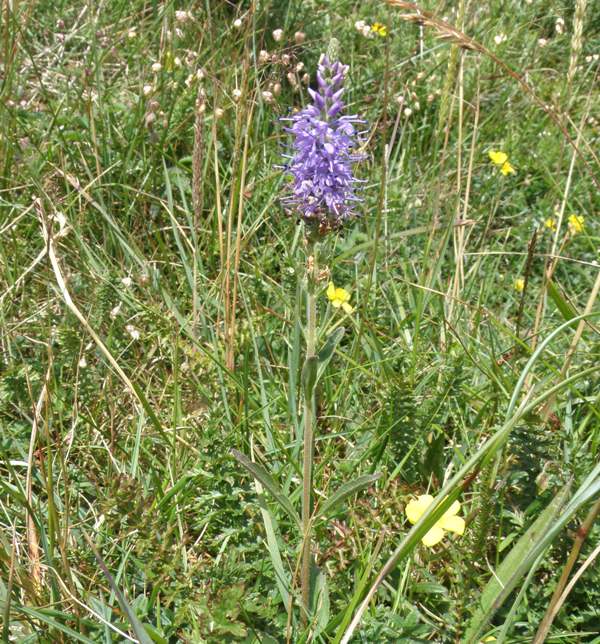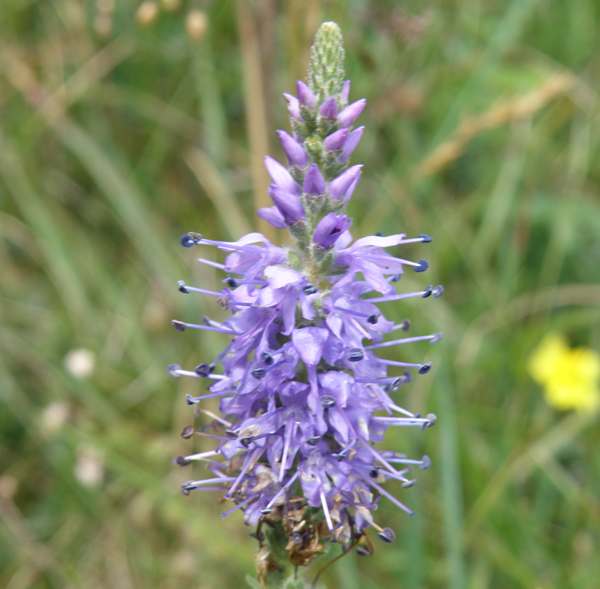Trees Birds Mammals Fish Amphibians Reptiles
Wild Algarve
Bookshop
Veronica spicata - Spiked Speedwell
Phylum: Magnoliophyta - Class: Equisetopsida - Order: Lamiales - Family: Plantaginaceae

One of Britain's rarest grassland wildflowers, Spiked Speedwell is the county flower of Montgomeryshire (Wales UK)..
Description
Distinguished by its dense, spiked inflorescence on an unbranching, ascending stem, Spiked Speedwell grows to a height of 10 to 40cm (usually 15 to 25cm). The stems are square in cross section and usually covered in dense grey hairs. The short-stalked flowers, which are usually purplish blue but very occasionally white, are 6 to 8mm across with fused petals in four lobes and prominent stamens. The finely hairy elongated oval leaves, whose margins are very finely crenate (with small rounded teeth), are stalked, arching and slightly ascending, and they are borne in opposite pairs along the stem, larger at the base and becoming progressively smaller towards the terminal raceme of flowers.

Distribution
Spiked Speedwell is rare in Britain. One of its remaining strongholds is Great Orme, near Llandudno in North Wales, where it grows in limestone grassland. There are scattered sites on alkaline soils in the Severn Estuary and on England's north-east coast and in the upper Ribble Valley, while southern Scotland also has at least one site for this rarity. In East Anglia there are sites on sandy soils where a subspecies of Spike Speedwell occurs.
Veronica spicata is also found in alkaline habitats in some parts of mainland Europe. Throughout the temperate world cultivars of this lovely speedwell have long been popular plants for parks and gardens.
Habitat
This pretty little wildflower is mostly confined to areas of thin soil on limestone grassland sites; however, in south-east England a subspecies is known to occur on mildly acidic to alkaline sandy soil.
Similar species
There are many Veronica species and separating them requires careful inspection of many characters; however, the growing habitat and spiked inflorescence make this one of the easier speedwells to identify... once you have found it.
Blooming Times
In Britain Spiked Speedwell blooms from late June through until early September.
Taxonomic note
In the past the various speedwells (of which there are many in Britain and Ireland) were classified in the family Scrophulariaceae. DNA analysis has shown that the vast array of species (some 5000 worldwide) formerly placed in the family Scrophulariaceae (the Figwort family) are not monophyletic (truly close relatives), and many genera have been transferred to other families within the Lamiales - some, as with the speedwells, are now in the family Plantaginaceae (the Plantain family); others have joined the broomrapes within the Orobanchaceae; but several new families have also been set up to accommodate groups of former 'Scrophs'.
Uses
Spiked Speedwell is the origin of many popular cultivars including 'Icicle' (a white spike), 'Red Fox' (red, of course), and 'Royal Candles' (with blue flower spikes).
Etymology
Speedwells were considered lucky, their sight on roadsides and under hedgerows considered to be good omen that would speed travellers on their way. Veronica, the genus name, probably comes from the Latin adjective vera- meaning true, and -nica meaning image. When St. Veronica wiped Christ's forehead on they way to his crucifixion on Mount Calvary, an image of his face was said to have been left on the cloth she had used.
The specific epithet spicata comes from Latin and means 'in spikes'.
Sue Parker's latest ebook is a revised and enlarged edition of Wild Orchids in The Burren. Full details here...
Buy it for just £5.95 on Amazon...
Sue Parker's new ebook is a comprehensive and fully revised edition of her acclaimed field guide to the Wild Orchids of Wales. Full details here...
Buy it for just £5.95 on Amazon...
Please Help Us: If you have found this information interesting and useful, please consider helping to keep First Nature online by making a small donation towards the web hosting and internet costs.
Any donations over and above the essential running costs will help support the conservation work of Plantlife, the Rivers Trust and charitable botanic gardens - as do author royalties and publisher proceeds from books by Pat and Sue.